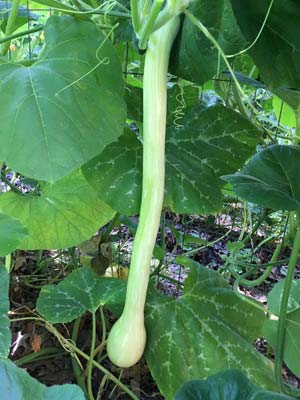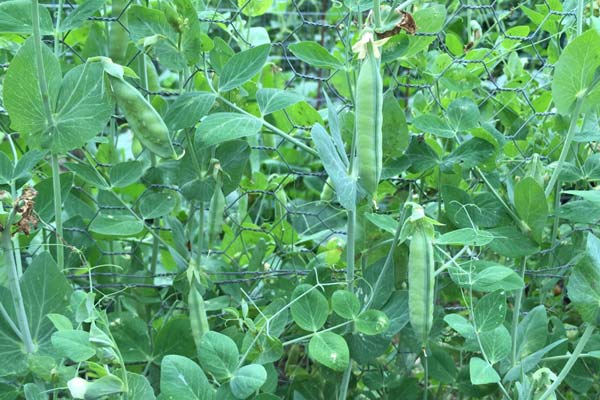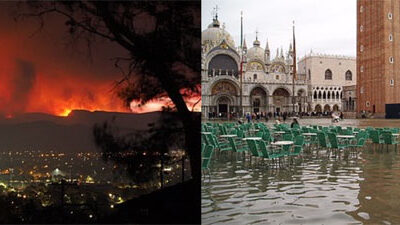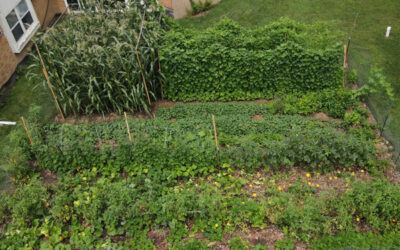- The Garden Food System – IV
- The Garden Food System – III
- The Garden Food System – II
- The Garden Food System – I
Basic Structure
Contrary to popular belief, the importance of self-sufficiency gardens is not confined to small scale, individual use. I believe I’ve now clearly documented that they can provide a substantial proportion of a country’s food and can do so far more efficiently than the industrial food system. At least, I’ve yet to see any credible evidence to the contrary. So the next step is to describe what a full-fledged U.S. garden food system (GFS) would look like, and how differently it would function than the industrial model.
In essence, we already have the foundation of a GFS, as about 124 million U.S. households currently have a food garden of one kind or another. However, these gardens are mostly small and are usually dismissed out of hand for the purposes of mass production, as no one knows what proportion of the U.S. food supply they provide. Why? Because neither our government, nor the food industry, nor any gardening organization tracks it. Which is strange, as Russia, despite giving household gardens no support whatsoever, does keep track of how much of the country’s food supply comes from them. (It’s about 50%.) If they can do it, why can’t we?
I will continue to describe the GFS as a three-tiered system, with 1) home and community gardens as the anchor, complemented by 2) local food sources such as farmers markets, CSAs, and community food webs, in turn backed up by 3) more distant, industrial food sources.
The garden anchor
The heart of the GFS anchor is household and community gardeners working their plots on an individual basis, mostly or entirely for their own or their family’s benefit. Next is the land, which is either adjacent to the homes where the gardeners live, or within a few minutes’ distance in the case of a community garden. Then there’s the set of outside suppliers that provide seeds, gardening tools, wheelbarrows, fences, etc. as well as compost, mulch, and water to those who may not have ready access to them. As well, many people will need some instruction in how to garden, either in-person from friends, in classes, from books and articles, or online.
Another layer of support would be businesses that provide greenhouse space for starter plants in areas that have freezing winter temperatures, which is to say most of the U.S. Yes, it’s already possible to buy tomato, pepper, and maybe a couple other kinds of starters at local venues of gardening supplies, but those places usually lack the variety desirable for a well-diversified garden. This essential garden need could thus be filled by either small, easy-to-erect greenhouses set up next to a garden, or by rented space in a larger, permanent community greenhouse. For that matter, farmers markets are often also a good place to get a wide variety of starters.
For those who don’t want to or can’t prepare a garden on their own, a garden-prep business could do it for them. Ideal would be to create beds about two feet wide and two feet deep so loamy and well infused with organic matter and nutrition that it could be easily maintained by the gardener indefinitely. Some people, especially if they’re not able-bodied, may even want to go a step further and simply hire someone to create and maintain their garden for them, so all they have to do is harvest the produce.
Not to be forgotten is services that provide pest protection and avoidance. Nothing is more discouraging than coming out some fine morning to visit your garden only to find that a gang of raccoons has destroyed your corn, or a deer has nipped your sweet potato starts to the ground, or squash vine borers have trashed your beautiful zucchini plants, or . . . you name it. I’ve had to deal with them all. Best to get expert advice from specialists who can tell you how to protect your crops without resorting to poisons or other destruction detrimental to the surrounding ecosystem.
 The final layer of support could come from government and non-governmental organizations such as the USDA’s The People’s Garden, the USDA Extension Service, The National Gardening Association, the American Community Garden Association, and others.
The final layer of support could come from government and non-governmental organizations such as the USDA’s The People’s Garden, the USDA Extension Service, The National Gardening Association, the American Community Garden Association, and others.
That’s pretty much it for the garden anchor. It’s a relatively simple system, the solid foundation of which already exists, and which would be easy to expand as enthusiasm for gardening increases.
Local food sources
This is the second tier of the GFS. In this country, it’s usually defined as farmers markets, CSAs, food hubs, urban farms, and garden markets. That’s supposed to and sometimes does mean food sourced from a friendly small farm a few miles down the road. In dry areas it can legitimately mean from food from further away than in areas with greater rainfall, making vegetables easier to produce in volume close to the customer. However, “local” has such cachet that grocery stores often extend the meaning to adjacent states, or to 18-wheeler trucked from as far as 24 hours away, which can easily be a thousand miles distant. So the term has come to mean almost nothing unless you’re able to ensure that the food it’s applied to was indeed produced somewhere reasonably nearby.
Community-based food webs, on the other hand, is defined not by some ambiguous distance but to a situation where farmers, processors, grocers, and consumers all live in the same local and cooperate in a way that enhances community vitality. It’s somewhat similar, on the global scene, to what’s been called “peasant food webs,” an umbrella term that can include “small holders” (usually meaning less than 5 acres, although there is controversy around that designation), family farms (also variously defined), fishers, hunters, and wild food gatherers. It can even include household gardens. Still, whether community- or peasant-based food webs, the intention is to operate outside of commodity production moving through the industrial supply chain.
Distant food sources
Then there’s the third source, which is anything not included in the first and second tiers. For the time being, that means the industrial food system in all its global reach, with the understanding that eventually parts of it could be cordoned off from the current IFS and “sustainabilized.” Industrial food is most of what we eat now in the U.S. (though not the world as a whole, in which it provides about 30% of the global food supply), but once the garden anchor really kicks in, food from the industrial sector will begin to fall off .
But I don’t think it will disappear by any means, nor should it. Like most people, I like pepper, avocados, coffee, chocolate, olive oil, and any number of other foods and seasonings that simply won’t grow in temperate climates. Besides, I don’t see anything wrong with industrial food production—and even long-distance shipping—that doesn’t cause collateral human and environmental damage. In other words, food that hews to organic/regenerative/sustainable agriculture and Fair-Trade means of production, even if it’s not as desirable as produce from the garden.
And which, by the way, avoids unhealthy food options. Environmentalists often seem to think that all industrial food system problems will be solved if we simply convert to organic sustainable agriculture. Well, did you know that you can purchase a shrink-wrapped, microwaveable, frozen, organic TV-dinner pizza? I’ve seen it myself. That’s not to say that all pizza is junk food, but I think you get the idea: changing the way our food is produced is pointless if we don’t move our diet away from excessive amounts of the highly processed stuff.
 So these are the three major tiers of the GFS, but it’s not as though they’re mutually exclusive. Given the broadest definition of each, the garden anchor overlaps a little with local food systems. They, in turn—especially when defined in terms of distance-cheating rather than community food webs—overlap a little with the industrial food system, the third tier. However, any way you look at it the garden anchor is “ultra-local,” nearby and community food webs are the next most local, and distant (industrial) sources are the least local. To boot, ultra-local gives you the most control over your food while making it the most broadly sustainable way to get a balanced, nutritious diet.
So these are the three major tiers of the GFS, but it’s not as though they’re mutually exclusive. Given the broadest definition of each, the garden anchor overlaps a little with local food systems. They, in turn—especially when defined in terms of distance-cheating rather than community food webs—overlap a little with the industrial food system, the third tier. However, any way you look at it the garden anchor is “ultra-local,” nearby and community food webs are the next most local, and distant (industrial) sources are the least local. To boot, ultra-local gives you the most control over your food while making it the most broadly sustainable way to get a balanced, nutritious diet.
That said, it’s not necessary for, say, a third of the population to grow all their food in self-sufficiency gardens, while the other two thirds get all their food from the industrial system. A much more practical scenario, in the short term, is for a third of our food overall to be produced in self-sufficiency gardens, but with each household providing just a healthy portion of its food supply from gardens, with the rest coming from local and/or industrial. I’ll discuss this more elsewhere, but in these times of climate change catastrophes and shaky global supply chains, just think how much more secure we would be as a country if a quite sizable portion of our food were produced in our yards rather than on farms an average of 1,500 miles away.





0 Comments